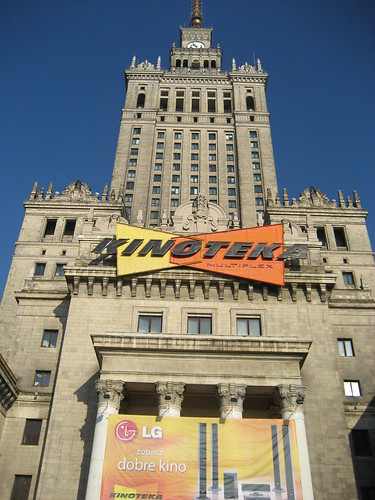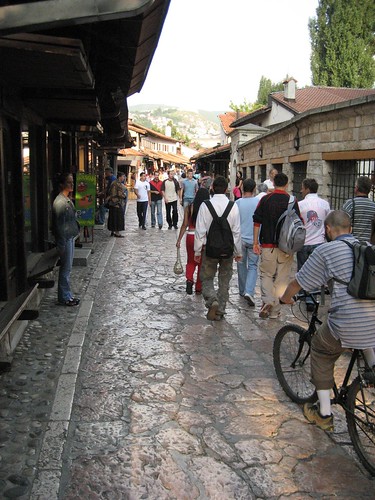VIENNESE VISA VACATION
Thursday, November 9th, 2006Vienna is a beautiful, well run European capital that has one of the best public transit systems that I have ever used. They have this really cool bike borrowing system called Citybike which we used the first day to ride along the Danube and through some of the parks (Including Prater) There are bike lanes, many wonderfully separated from traffic and pedestrians, and bike signals and signage nearly everywhere you want to go. You get bikes form one of the 50 stations by using your credit card and a one time registration that you can do right at the station. And amazingly the bikes are free for the first hour, and only a euro or so after that, and you can return them to any other station. The bikes seem to have airless tires, but are not too clunky. We did notice yesterday that one of the stations was broken and that it seems many bikes are available downtown, but fewer up the hills outside the inner ring. So we’re wondering if they have to move the bikes around to maintain a balance. Anyways the system is great and seems to be well used by locals, although we are the only tourists we’ve seen on them.

Well, all I can say is that everything so far on our trip has gone nearly perfectly, so it’s about time that something went a little awry. It appears in my meticulous planning over the past year that I totally misfiled the need for an Indian Visa in my brain. I was reading about each major destination that we were going to about a month at a time and made some notes about India, but apparently totally forget that we needed to get a visa in San Francisco prior to departure in August. I have the visas we need to get on the road all set, by checking on getting visas for Laos, Cambodia, and Vietnam in Bangkok, and getting a Chinese Visa in Sydney. No problem. So when Cheryl discovered on Sunday in the Czech republic that we DID need a visa, we checked the Indian Embassy web site and got an application. It appeared we could get a visa in one day so we diligently filled out the applications on Monday night with the intent of getting to the Embassy first thing at opening to turn in our applications. Now, I was a bit stressed about this already, since our flights were set for Thursday (yes today, so you can see where this is going…), and I had booked the Delhi hotel, airport pick-up, two overnight trains, and a room in Varanasi.
Now the following is one of the reasons why Cheryl and I make such a good team, with the perfect combinations of Type A and Type B behavior. (And why I love her so) She read on the 5 page instruction sheet Monday night that the one-day thing was only for Austrian nationals and other foreign nationals could take four days. But she nicely waited to tell me this until the next morning when we were riding the (clean, low-boarding, and frequent) bus down to the Ringstrasse. What, what what? 4 Days? So I slept well Monday night as she correctly figured that this would kind of set me off, and sure enough when we got to the Embassy he told us that it would be Friday as the need to get clearance from Washington for Americans. We explained we were flying on Thursday, but clearly there was not much they could do, and after all, this was all our fault ( o.k. my fault). After some more pleasant edged conversation, he did say that he could scribble an urgent request at the top of the faxes, but that was the limit of his power, as there were no other special rush methods available. Our first lesson in the methodical, yet polite ways of Indian Bureaucracy. I believe it is a somewhat American trait to always believe theathere must be a way to get something done, with enough rush fees, or some other special process.
So to make a long story a bit shorter, we delayed our flight on Austrian Airlines until tomorrow (thank you flexible RTW tickets and there were seats) and after checking in with Embassy yesterday, he was somewhat reassuring that if we stopped by late this afternoon that the Visas should be ready. But he is not positive, so we’re living a bit on the edge now as delaying another day will be a mess, since I’ll have to cancel and rebook all our trains and hotels, and the availability of both of these is challenging, as Indian trains are way overburdened. Right now we just shortened our stay in Delhi from one two to one night, which some people may actually argue is a smart move regardless.
So wish us luck, and if you don’t hear from us in a few days, then let’s all assume that we flew out tomorrow, otherwise I’ll be right back here at the Internet cafe again to dump my brain. At least we are ‘stuck’ in Vienna, which has lots of grand museums and other sights to explore. Yesterday we went to the grand Kunsthistorisches museum and today we rode trams and buses out to the nice hills North of the city, full of trails, vineyards, and some nice old homes. And yes, we even found a good microbrewery last night called 7Stern Brau that had this amazing ‘RauchBier’ that was nice and smokey and completely unique. And the beer comes in convenient 5-pound liters to avoid the pesky need to reorder too often.





 found the areas just outside the old city kind of a mess. Our room (with fridge and hot water) was about a mile north of the entrance to the old city; however, it was just a little too far from the trams to be convenient, and the walking was awful to and from the place, since the sidewalks and intersections are blocked with cars. Everyone weaves around the cars and the little space left is too little to walk side by side, so Cheryl and I would literally walk full speed single file for a mile. An odd consequence of these miserable walking conditions (oh and there are lots of people walking), seems to be that people clearly just want to get thru the area as fast as possible. We had old ladies pass us walking at 4 mph, and the younger folks hit nearly 6 mph. Yup, wolds fastest walkers. Don’t stop to tie your shoes.
found the areas just outside the old city kind of a mess. Our room (with fridge and hot water) was about a mile north of the entrance to the old city; however, it was just a little too far from the trams to be convenient, and the walking was awful to and from the place, since the sidewalks and intersections are blocked with cars. Everyone weaves around the cars and the little space left is too little to walk side by side, so Cheryl and I would literally walk full speed single file for a mile. An odd consequence of these miserable walking conditions (oh and there are lots of people walking), seems to be that people clearly just want to get thru the area as fast as possible. We had old ladies pass us walking at 4 mph, and the younger folks hit nearly 6 mph. Yup, wolds fastest walkers. Don’t stop to tie your shoes. It also contains the excellent (and undersold) ethnographic museum containing 3 floors of Polish folk culture, including reconstructed rooms from houses of the more common people.
It also contains the excellent (and undersold) ethnographic museum containing 3 floors of Polish folk culture, including reconstructed rooms from houses of the more common people. 

 We visited the Technical Museum which had some vary cool old mechanical devices and displays, including what must be the worlds largest collection of Typewriters (mostly Eastern European). The Roman ruins under the old square have been restored into a mini-mueum with skylights to the square. They even use some of the space for public events, as they were setting up for a reception that evening.
We visited the Technical Museum which had some vary cool old mechanical devices and displays, including what must be the worlds largest collection of Typewriters (mostly Eastern European). The Roman ruins under the old square have been restored into a mini-mueum with skylights to the square. They even use some of the space for public events, as they were setting up for a reception that evening. They were pleasant and bizarre. And they’d never have made it out of the art commissions halls in San Francisco. One of the stranger sights that we have run into in the former eastern Bloc.
They were pleasant and bizarre. And they’d never have made it out of the art commissions halls in San Francisco. One of the stranger sights that we have run into in the former eastern Bloc.
 The upside of this slow change is that there is still some remnants of traditionally Slovakian way and dress. We saw an older man bring in two horses and a wooden cart right into the bus depot, and leave them to go get his morning snack and coffee.
The upside of this slow change is that there is still some remnants of traditionally Slovakian way and dress. We saw an older man bring in two horses and a wooden cart right into the bus depot, and leave them to go get his morning snack and coffee.






 It’s like an urban slalom, except that the cars and trucks are much less forgiving than snow, or even traffic in most US cities that I’ve biked in, including NYC. We now understand why the bike rental shop people kind of gave us a ‘hope you don’t die’ look as we confidently pedaled away from their shop into the craziness that is Pest at rush hour.
It’s like an urban slalom, except that the cars and trucks are much less forgiving than snow, or even traffic in most US cities that I’ve biked in, including NYC. We now understand why the bike rental shop people kind of gave us a ‘hope you don’t die’ look as we confidently pedaled away from their shop into the craziness that is Pest at rush hour. 



